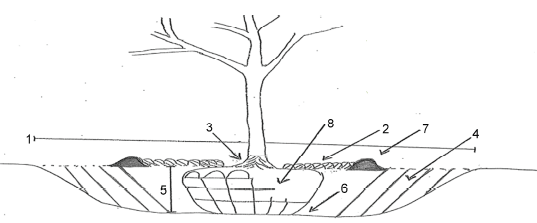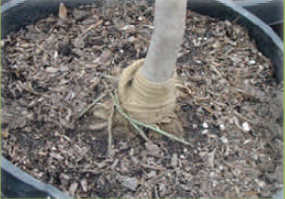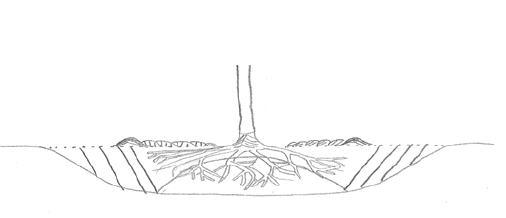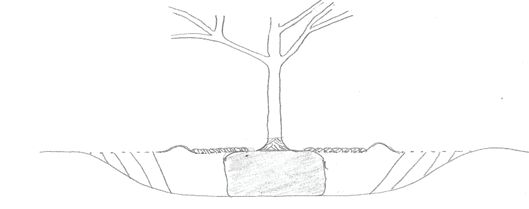Introduction
Adding a tree to your landscape is an investment in your property. A tree will add natural beauty to the landscape and provide needed shade for your home and family. Properly planting a tree will give it a good start toward a long life.
There is a science to properly planting a tree to provide it with the optimal conditions for longterm success. Although trees can be planted almost any time of the year, the best time is during the fall and early winter months. The soils are still warm and better able to retain moisture than in summer, so the tree is less likely to suffer from transplant stress. Fallplanted trees can focus energy on root establishment in the new environment before winter cold sets in. With appropriate care over the winter, trees planted during the fall will usually outperform those planted in late winter or spring. Trees planted in summer, when temperatures are in the 90s F and above, often lose their leaves due to transplant shock and may not be able to recover.
Trees are sold in different forms
Trees purchased from a local nursery are sold in containers, balled-and-burlapped or bareroot.
Container-grown trees are grown from seedlings using a soilless growing medium as a base. Containers are made of plastic, wood or even biodegradable peat moss. Seedlings are gradually stepped up into larger containers as their size increases. A root bag is a form of container for trees. The bag is usually made of plastic or fabric.
Balled-and-Burlapped (B&B) trees are grown in the ground, and then root-pruned prior to hand or mechanical removal. The tree root balls, surrounded by soil, are wrapped with chemically treated burlap, held together with twine and, in some cases, placed in wire baskets. B&B trees are the largest of the three types of cultivated trees commonly available for purchase.
Bareroot trees are dug and shipped while dormant, without soil around their roots. There are advantages to planting bareroot trees. More long stabilizing roots are retained than with balled-and-burlapped trees, and they are easily inspected for damaged, deformed or circling roots. The lack of soil around the roots allows them to adapt well to the native soil on the site. The results can be higher quality plants with better transplant success. Bareroot trees are only available in late winter and early spring, and must be planted within a week of purchase. When planted in complete dormancy, these trees have the opportunity to acclimate to the soil conditions and come out of dormancy at the appropriate time for the area and climate.
Proper planting is key to success
Providing a wide planting hole and appropriate moisture is critical to a tree’s success. The following are tips for planting a tree in Nevada’s dry climate.
Site selection – Before purchasing your tree, assess your landscape and decide whether you have enough space to accommodate the tree you want. Stand at the site you will plant, and look up; existing power lines will reduce a tree’s potential height. Look down; call the local utility company to identify where buried water, gas and power lines are located.
Tree selection – Select a tree species that will be the appropriate size at maturity for the location. Choose a plant that is healthy with no signs of disease or insects. It should have a strong trunk with good structural branching. If in a container, you should be able to see the root flare (Figure 1) above the soil line. Avoid purchasing trees with large roots extending through the drainage holes of the container or circling around the inside of the container. You will have to remove the tree from its container to see this.
The planting hole – Dig the planting hole at least two to three times the width of the container or root ball, and no deeper than the height of the root ball. A wide planting hole provides room for the roots to grow laterally. Never dig into the soil at the base of the planting hole. The root ball must be supported at the base of the hole, and the soil under the root ball should be firm to prevent settling after planting. When possible, provide the tree with an optimal rooting environment beyond the planting hole by loosening the top 12-18 inches of soil to a width of up to five times the root-ball diameter.
Soil drainage – Test the soil for adequate drainage before you plant. Most trees do not like “wet feet,” and prolonged wetness around their roots can lead to plant death. To test for drainage, fill the planting hole half full with water. Let it sit for a few hours. If the water is gone after two to three hours, drainage is adequate. If the water does not drain within 12 hours, choose another location for your tree.
Planting your tree
Container-grown trees should be removed from their containers, and large circling roots gently pulled out and away from the root ball. This stimulates the roots and encourages them to grow outward into the native soil instead of circling around the planting hole. Score the sides of the root ball before planting to reduce the impermeable interface between the root ball and the sides of the planting hole.
- Hole width at least two to three times the width of the root ball – loosen soil to 5 times for increased rooting area.
- 2-inch to 3-inch layer of mulch – keep at least 2 inches away from trunk.
- Root flare.
- Area of loosened soil.
- Hole depth is equal to the distance from the root flare to the bottom of the root ball.
- Firm ground.
- Soil berm for complete wetting of root ball and surrounding soil.
- Cut and remove the top onethird to one-half of the wire and burlap; any remaining burlap should be sliced with a sharp knife.

Figure 1. B&B planting with proper planting tips.
B&B trees should be set in the planting hole and all of the burlap, twine and wire removed, if possible. When dealing with large B&B trees, removal of all the burlap or wire can be difficult. In this case, remove the top onethird to one-half of the wire and burlap; any remaining burlap should be sliced with a sharp knife to encourage root growth. Nurseries often hold B&B trees over the winter in plastic containers. In this case, twine and burlap should be removed at the time of planting (Figure 2).

Figure 2. Nurseries often hold B&B trees over the winter in plastic containers. Twine and burlap should be removed at the time of planting.
Bareroot tree roots should be thoroughly cleaned and rinsed free of all packing material. Once you can see the roots, remove any broken, diseased or girdling roots with sharp, sanitized pruners. If you are planting grafted trees, look for a paint mark above the graft union; this mark designates true north and the direction in which the tree was growing in the field prior to harvest. It will benefit the tree if you can plant it in the same position. Build a small, compacted mound of native soil at the bottom of the planting hole (Figure 3). The clean roots (free of all packing materials) should be spread and distributed around the mound. The sides of the planting hole should be scored or loosened to encourage root growth into the native soil.

Figure 3. Bareroot planting with mound.

Figure 4. Container planting with berm.
Backfilling – Once the tree is in place, gently position it so the root flare will be visible above the soil line after planting. Backfill the planting hole with the native soil that was removed when the hole was dug. Remove large rocks or debris before backfilling. It is not necessary or advisable to add fertilizers at this time. Soil amendments such as compost, aged manure or peat moss are best blended into the top 8 to 12 inches of backfill; the most active root growth will occur in this area. Amendments should not exceed 20 percent of the fill material. It is important to create a natural soil rooting environment free of excessive additives. A common mistake is making the planting hole too rich. This discourages root growth into the native soil and creates a “virtual pot” in the ground. As you add soil back into the planting hole, tamp the soil lightly to remove air pockets.
For all types of trees, once the hole is filled, build a berm as wide as the planting hole around the tree (Figure 4). This will create a basin you can then fill with water to ensure the entire root ball receives moisture.
Pruning – After planting your tree, only remove broken, damaged or dead branches. Lower branches on the trunk will protect the young bark from temperature extremes; they can be removed if desired in three to five years as the tree matures.
Staking – Staking is not necessary and, when installed improperly, can cause harm to the tree. When support is required because of wind, tree size or terrain, trees should be staked to anchor their root balls so roots growing into adjacent soil are not injured when the tree moves. The number of stakes required varies with the size of the tree. For general staking and to anchor large B&B root balls, drive two stakes into firm soil on opposite sides of the tree and outside the planting hole, perpendicular to the direction of the prevailing winds. Connect the stakes to the trunk with flexible ties that will allow the tree to move slightly with the wind. Check the ties often to prevent girdling of the trunk. Ties should be placed below the lowest branch to prevent rubbing damage. Stakes should not be left in place more than one to two years.
Mulching – Mulch around the tree to its drip line with 2 to 3 inches of organic mulch (bark, wood chips, leaves, conifer needles, shredded pine needles, chemical-free lawn clippings, straw, hulls or coarse compost). These materials will break down naturally and provide organic matter to improve the soil. Use of organic mulch around trees has been shown to conserve soil moisture; reduce soil temperature; reduce soil erosion; increase soil fertility; reduce weeds; and protect the soil and roots from soil compaction due to foot traffic, equipment and heavy rain impact. Keep mulch 2 inches away from the trunk of the tree to prevent excessive moisture on the trunk and rodent damage.
Irrigation – Proper watering is critical for newly planted trees. Depending on exposure and soil conditions, the amount of water needed by each tree will vary. A thorough soaking of the root ball with water is much better than shallow, frequent watering. When using drip irrigation, it is beneficial to place at least four emitters around each tree to encourage root growth in all directions. Emitter size will vary depending on the size of the tree and soil conditions.
Fertilization – Avoid fertilizing your new tree for the first growing season. This first year, the tree needs to acclimate to the new conditions and create a strong root system. Adding compost as mulch, or below the mulch, will slowly and naturally provide nutrients to the tree.
Protection – When lower branches are not present, trunk protection is needed to prevent damage to the bark of young trees. Using loose expanding wraps on deciduous trees can be beneficial during the winter months to prevent sunscald or winter burn of the trunk. Animals can also damage the trunks of trees, and not just rabbits, voles and deer. Dogs, cats and humans also can damage trunk tissue. String trimmers and lawn mowers are especially damaging and can easily girdle and kill young trees. Remember to remove these protective wraps in early spring.
With proper planting and care, your new tree will grow into a wonderful shade tree or windbreak, and will thrive through most of your lifetime.
References
Gillman, J. 2009. How Trees Die, The Past, Present, and Future of our Forests. Westholme Publishing, Yardley, PA.
Harris, R.W., J.R. Clark, and N.P. Matheny. 2004. Arboriculture, Integrated Management of Landscape Trees, Shrubs, and Vines. Prentice Hall, Upper Saddle River, NJ.
Watson, G.W. and E.B. Himelick. 1997. Principles and Practice of Planting Trees and Shrubs. International Society of Arboriculture, Champaign, IL.
Lilly, S.J. 2001. Arborists’ Certification Study Guide. International Society of Arboriculture, Champaign, IL.
Urban, J. 2008. Up By Roots: Healthy Soils and Trees in the Built Environment. International Society of Arboriculture, Champaign, IL.
Kratsch, H., Hanson Mazet, W.
2015,
Planting Trees in Northern Nevada Landscapes,
Extension | University of Nevada, Reno, Fact Sheet FS-15-02


